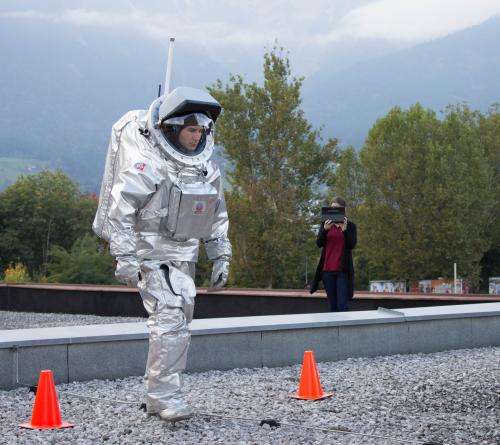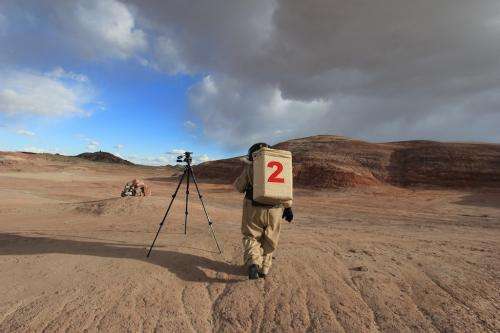World Space Walk 2013: Three Mars analogue spacesuit teams perform simultaneous experiments

One of the key elements of equipment for a future human expedition to Mars will be a spacesuit that allows astronauts to roam the Martian surface. Now, for the first time, three Mars analogue suit development teams around the world have performed simultaneous experiments, coordinated from a single mission control centre. The experiments are a first step in developing a universal standard for comparing Mars analogue suits in terms of the impact they have on the agility and dexterity of the suit wearers. The 'World Space Walk 2013' coordinated tests took place on Tuesday 8th October as a highlight of World Space Week 2013, which this year has the theme of 'Exploring Mars, Discovering Earth'. The tests were designed and led by the Austrian Space Forum, which also provided the Mission Control Centre for the campaign. The spacesuit experiments were carried out in Innsbruck, North Dakota and Utah, with additional support from France.
Explorers on the surface of Mars will face a cold, dusty environment with a thin atmosphere of mainly carbon dioxide. Away from any settlement on an Extra Vehicular Activity (EVA), they will need to rely on their spacesuit to provide oxygen to breathe and a comfortable temperature, pressure and atmosphere in which to work.
Experiment designer, Alexander Soucek of the Austrian Space Forum, explains, "In order to provide the safe environment needed by astronauts, spacesuits can be cumbersome and heavy. If future mission planners are to select the right suit for the right expedition, they need to have independent data for comparing and evaluating suits created by different teams."
The 'World Space Walk' spacesuit testers performed agility and mobility tasks wearing:
- the Aouda.X suit developed by the Austrian Space Forum in Innsbruck, Austria
- the NDX-2 suit developed by the Human Spaceflight Laboratory of the University of North Dakota, USA
- analogue suits at the Mars Desert Research Station (MDRS), Utah, USA.
The deep-sea diving specialists, Comex, in Marseille, France also participated in the tests by monitoring telemetry data from the suits. Comex is the designer of the Gandolfi spacesuit, which was used recently by the European Space Agency to recreate the activities of the Apollo 11 astronauts under the sea in the Bay of Marseille.

The World Space Walk suit testers performed the following three experimental activities wearing their Mars analogue spacesuits:
1) Complete an obstacle course. Erect a tripod. Mount a gnomon (sundial) on tripod.
2) Complete an obstacle course. Take a camera from the spacesuit's pocket. Take pictures of feet and horizon pointing north, south, east and west.
3) Complete an obstacle course. Take out a sample bag, collect a rock sample and place in the bag. Label the sample bag and place in container.
"The World Space Walk experiments are designed to give a statistical measurement of the average time delay between performing typical activities wearing the spacesuit as compared to performing same activities unsuited," says analogue astronaut, Luca Foresta, who participated in the experiments wearing the Aouda.X suit.
The World Space Walk tests are a continuation of experiments run by the Austrian Space Forum during their Mars 2013 analogue field-campaign, which took place in Morocco in February this year. During the campaign, analogue astronauts carried out six experiments first wearing the Aouda.X suit and then without the suit, testing out different aspects of agility e.g. walking over rough terrain or the dexterity of hands and fingers when working with small technical devices. The analogue astronauts followed pre-defined movement patterns along an obstacle path of 9 meters by 20 metres. Results from the Mars 2013 tests have been submitted for publication in a special edition of the scientific journal, Astrobiology, for publication in early 2014.
"If we are going to prepare for a human mission to Mars in the future, we need to have as much knowledge as possible on the practicalities and limitations of working in spacesuits on planetary terrains. For World Space Walk 2013, we have had the amazing opportunity to work with four different teams who are developing spacesuits and to collaborate on the same set of tasks. This technical test is a simple, yet important, first milestone to compare different analogue suit systems worldwide and to contribute to a growing area of research," says Gernot Groemer, the President of the Austrian Space Forum.
Provided by Europlanet Media Centre


















